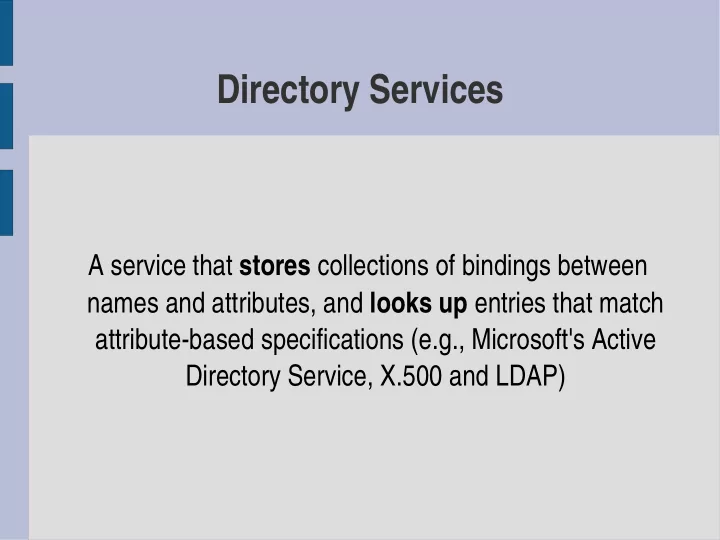

Directory Services A service that stores collections of bindings between names and attributes, and looks up entries that match attribute-based specifications (e.g., Microsoft's Active Directory Service, X.500 and LDAP)
Case Study - X.500 ● X.500 is a directory service primarily used to satisfy descriptive queries, discovering names and attributes of other users or system resources ● White Pages Service - obtaining a specific translation - what is such-and-such a user's e-mail address? ● Yellow Pages Service - obtaining grouped information - list all garages that can repair my Ferrari ● Such queries may originate from users or from processes ● Users can search the directory for specific information with only partial knowledge of its name, structure or content
X.500 Directory Service ● The ITU and ISO defined the X.500 standard as part of the ISO OSI seven-layer model ● X.500 is designed to be a service for access to information about “ real-world entities " ● It is specified as an application-level service within OSI, and can be viewed as a design for a general-purpose directory service ● It is the basis for LDAP and is used in the OSF's DCE directory service technology
X.500 Namespace ● Organized as a tree structure ● A wide range of attributes are stored at each node in the tree ● Access is not just by name but also by searching for entities with any required combination of attributes
DIT and DIB ● The X.500 tree is called the Directory Information Tree (DIT) ● The tree and its associated data is called the Directory Information Base (DIB) ● There is intended to be a global DIB with portions of the world-wide DIB managed by individual X.500 servers ● Each entry in the DIB consists of a name and a set of attributes
Clients and X.500 ● Clients access the directory by establishing a connection to a server ● If the data required are not in the segment of the DIB held by the contacted server, it will invoke other servers to resolve the query or redirect the client to another server ● X.500 Servers - known as Directory Service Agents (DSA) ● X.500 Clients - known as Directory User Agents (DUA)
X.500 Service Architecture DUA DSA DSA DSA DUA DSA DSA DUA DSA
Part of the X.500 DIT X.500 Service (root) ... France (country) Great Britain (country) Greece (country) ... ... BT Plc (organization) University of Gormenghast (organization) ... Computing Service (organizationalUnit) ... Department of Computer Science (organizationalUnit) Engineering Department (organizationalUnit) ... Departmental Staff (organizationalUnit) ... ely (applicationProcess) Research Students (organizationalUnit) ... ... ... Alice Flintstone (person) Pat King (person) James Healey (person) Janet Papworth (person) ...
An example X.500 DIB Entry info Alice Flintstone, Departmental Staff, Department of Computer Science, University of Gormenghast, GB commonName uid Alice.L.Flintstone alf Alice.Flintstone Alice Flintstone mail A. Flintstone alf@dcs.gormenghast.ac.uk surname Alice.Flintstone@dcs.gormenghast.ac.uk Flintstone roomNumber Z42 telephoneNumber +44 986 33 4604 userClass Research Fellow
Implementing X.500 ● As a standard ( recommendation ), X.500 does not address implementation issues ● It should be clear that any implementation must involve multiple servers organized as a WAN, with extensive use made of replication and caching
X.500 and LDAP ● University of Michigan proposed the Lightweight Directory Access Protocol (LDAP) in which DUAs access X.500 servers directory over TCP/IP (as opposed to an application-level OSI protocol) ● LDAP is defined in RFC 2251, and provides a simple API for directory access and does away with X.500's requirement to use ASN.1 as the default textual encoding ● LDAP is based on X.500 but does NOT require it ● LDAP is widely used, for example, Microsoft's ADS provides an LDAP interface ● LDAP is particularly used for organizational intranet directory services
Name Services Summary Name services store the attributes of objects in a distributed system - in particular, their addresses - and return these attributes when a textual named is supplied to be looked up
Recommend
More recommend